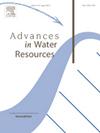Characteristics of flow and transport in low-permeability fractured rock based on a channel network model
IF 4
2区 环境科学与生态学
Q1 WATER RESOURCES
引用次数: 0
Abstract
Discrete Fracture Network (DFN) models for evaluating flow and transport in low-permeability fractured rocks are important tools in safety assessments of nuclear waste repositories, and also important for other geoengineering and environmental applications. The well-known phenomena of flow channeling, arising from both intra-fracture and inter-fracture heterogeneities, is in general difficult to implement in these models. The present study uses the Channel Network Model (CNM) concept as a complementary approach to DFN models, with focus on channelized flow within fracture planes and in the fracture network. A method used to generate CNMs based on channels connecting centroids of fracture planes was implemented within a pychan3d library and applied to a 3D DFN model based on field data from Forsmark, Sweden. Three sets of realizations of the channel network are used to characterize the flow and transport system between deformation zones in the granitic host rock. The results indicate the significance of very low-conductivity fractures in providing critical flow connections in these rocks. It is shown that only a few (4 to 6 in our cases) key flow bridges within a network of 9000 or more fractures control its flow and transport. The use of CNMs together with DFN models enhances confidence in safety assessments for nuclear waste repositories and other applications, while providing valuable insights into complex flow and transport behavior in low-fracture-permeability rocks.
基于通道网络模型的低渗透裂隙岩体流动输运特征
离散裂缝网络(DFN)模型用于评估低渗透裂缝岩石的流动和输运,是核废料处置库安全评估的重要工具,对其他地球工程和环境应用也很重要。众所周知的由裂缝内和裂缝间非均质性引起的窜流现象通常难以在这些模型中实现。本研究使用通道网络模型(CNM)概念作为DFN模型的补充方法,重点关注裂缝面和裂缝网络中的通道化流动。在pychan3d库中实现了一种基于连接裂缝面质心的通道生成cnm的方法,并将其应用于基于瑞典Forsmark现场数据的3D DFN模型。利用三组通道网络实现来表征花岗质寄主岩石变形带之间的流动和输运系统。结果表明,极低导流率裂缝在这些岩石中提供临界流动连接方面具有重要意义。研究表明,在9000个或更多裂缝的网络中,只有少数(在我们的案例中是4到6个)关键流桥控制着它的流动和输送。cnm与DFN模型的结合使用增强了对核废料储存库和其他应用的安全性评估的信心,同时为低裂缝渗透率岩石的复杂流动和输送行为提供了有价值的见解。
本文章由计算机程序翻译,如有差异,请以英文原文为准。
求助全文
约1分钟内获得全文
求助全文
来源期刊

Advances in Water Resources
环境科学-水资源
CiteScore
9.40
自引率
6.40%
发文量
171
审稿时长
36 days
期刊介绍:
Advances in Water Resources provides a forum for the presentation of fundamental scientific advances in the understanding of water resources systems. The scope of Advances in Water Resources includes any combination of theoretical, computational, and experimental approaches used to advance fundamental understanding of surface or subsurface water resources systems or the interaction of these systems with the atmosphere, geosphere, biosphere, and human societies. Manuscripts involving case studies that do not attempt to reach broader conclusions, research on engineering design, applied hydraulics, or water quality and treatment, as well as applications of existing knowledge that do not advance fundamental understanding of hydrological processes, are not appropriate for Advances in Water Resources.
Examples of appropriate topical areas that will be considered include the following:
• Surface and subsurface hydrology
• Hydrometeorology
• Environmental fluid dynamics
• Ecohydrology and ecohydrodynamics
• Multiphase transport phenomena in porous media
• Fluid flow and species transport and reaction processes
 求助内容:
求助内容: 应助结果提醒方式:
应助结果提醒方式:


